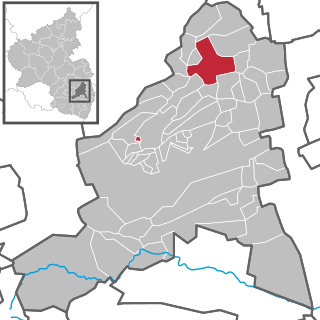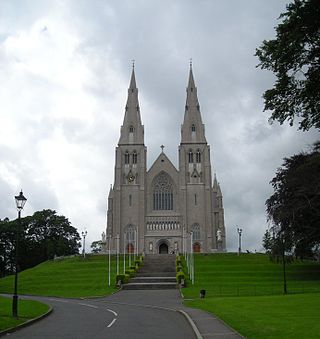Boyounagh is a rural village in County Galway, Ireland, northwest of Glenamaddy.
Boyounagh is a rural village in County Galway, Ireland, northwest of Glenamaddy.
The old church of Boyounagh is all destroyed with exception of a fragment of the north wall. The building was 18 ft (5.5 m) wide but its length cannot be ascertained. The natives relate there was a monastery; traces of a foundation of an abbey called An Mainistir are pointed out a short distance to the east of the old graveyard.
The site of the old church is almost in the centre of the pre-Norman Ballybetagh, old town land of Boyounagh. In the 16th/17th century inquisitions it was returned to grand juries as "Ye Fower quarters" of Boyounagh belonging to the Protestant Archbishop of Tuam. The old church of Boyounagh was sited in and surrounded by church lands. In modern times these four quarters consist of eight ordnance survey town lands including Cloonkeen, Meelick, Boyounagh Beg, alias Cunningham village, Boyounagh More alias Middletown and Cashel. In the latter days of landlordism it was called the Boyounagh Estate.
Boyounagh was once mentioned in the Annals of Four Masters when in 1137 the church was burned. There is a tradition that Saint Patrick founded the first church in Boyounagh. Whilst the Annals do not mention St. Jarlath we know he founded a monastery in Tuam in the 5th/6th century and it is probable that the "Coarbes" successors of St. Jarlath had jurisdiction over places like Boyounagh.
Lord Fitzgerald was leaseholder of Boyounagh Estate until his death in 1843. Then Martin McDonnell bought it on 20 June 1859 for £5,850. The Boyounagh estate consisted of Cloonkeen, Meelick, Cashel, Middletown and Gorthaganny. The area of these town lands was 3,914 acres. Martin McDonnell was a merchant from Dunmore. It was said he was a fortunate man to own all of 12,000 acres, collecting all his rent. Tradition has it that he was a good landlord. He died in 1912. His tomb was built in the highest spot so that it could be seen from his house in Dunmore.

Tuam is a town in Ireland and the second-largest settlement in County Galway. It is west of the midlands of Ireland, about 35 km (22 mi) north of Galway city. Humans have lived in the area since the Bronze Age while the historic period dates from the sixth century. The town became increasingly important in the 11th and 12th centuries in political and religious aspects of Ireland. The market-based layout of the town and square indicates the importance of commerce.

Killala is a village in County Mayo in Ireland, north of Ballina. The railway line from Dublin to Ballina once extended to Killala. To the west of Killala is a Townsplots West, which contains a number of ancient forts.

St Jarlath's College is a Catholic secondary school for young men in Tuam, County Galway. The college was founded in 1800 and in 2009 absorbed St. Patrick's College, Tuam. The College, which operates under patronage of the Archbishop of Tuam, is named after Jarlath, or Iarlaith, who founded a monastery in the town when, as legend has it, his chariot wheel broke. The enrolment numbers in 2022 are 595.

Saint Jarlath, also known as Iarlaithe mac Loga, was an Irish priest and scholar from Connacht, remembered as the founder of the monastic School of Tuam and of the Archdiocese of Tuam, of which he is the patron saint. No medieval Life for Jarlath is extant, but sources for his life and cult include genealogies, martyrologies, the Irish Lives of St Brendan of Clonfert, and a biography compiled by John Colgan in the 17th century.

Blacklion is a border village in west County Cavan, Ireland. It is situated on the N16 national primary road, just across the border from the County Fermanagh village of Belcoo.

Grünstadt is a town in the Bad Dürkheim district in Rhineland-Palatinate, Germany with roughly 13,200 inhabitants. It does not belong to any Verbandsgemeinde – a kind of collective municipality – but is nonetheless the administrative seat of the Verbandsgemeinde of Leiningerland.

The Archdiocese of Armagh is an ecclesiastical territory or archdiocese of the Catholic Church located in the northern part of Ireland. The ordinary is the Roman Catholic Archbishop of Armagh who is also the Metropolitan of the Ecclesiastical province of Armagh and the Primate of All Ireland. The mother church is St Patrick's Cathedral. The claim of the archdiocese to pre-eminence in Ireland as the primatial see rests upon its traditional establishment by Saint Patrick circa 445. It was recognised as a metropolitan province in 1152 by the Synod of Kells.
Cathal mac Finguine was an Irish King of Munster or Cashel, and effectively High King of Ireland as well. He belonged to the Eóganacht Glendamnach sept of the dominant Eóganachta kin-group whose members dominated Munster from the 7th century to the 10th. His father, uncle, grandfather and great-grandfather had also been kings of Cashel, as were his son and grandson.

Saint Colmán of Cloyne, also Colmán mac Léníne, was a monk, founder and patron of Cluain Uama, now Cloyne, County Cork, Ireland, and one of the earliest known Irish poets to write in the vernacular.

The Archdiocese of Tuam is an ecclesiastical territory or archdiocese of the Catholic Church located in western Ireland. The archdiocese is led by the Archbishop of Tuam, who serves as pastor of the mother church, the Cathedral of the Assumption and Metropolitan of the Metropolitan Province of Tuam. According to tradition, the "Diocese of Tuam" was established in the 6th century by St. Jarlath. The ecclesiastical province, roughly co-extensive with the secular province of Connacht, was created in 1152 by the Synod of Kells.

The Diocese of Killala is a Roman Catholic diocese in Connacht; the western province of Ireland. It is in the Metropolitan Province of Tuam and is subject to the Metropolitan Archdiocese of Tuam. The current bishop is Dr. John Fleming DD who was appointed on 7 April 2002.
Newtowncashel is a village located near Lough Ree in County Longford, Ireland. It is within the townland of Cornadowagh. Newtowncashel won the Irish Tidy Towns Competition in 1980.

The United Dioceses of Dublin and Glendalough is a diocese of the Church of Ireland in the east of Ireland. It is headed by the Archbishop of Dublin, who is also styled the Primate of Ireland. The diocesan cathedral is Christ Church Cathedral, Dublin.
Rickard de Bermingham, otherwise Rickard Mac Fheorais, was Anglo-Irish lord of Athenry.

St Mary's Cathedral is a cathedral church of the Diocese of Tuam, Limerick and Killaloe in the Church of Ireland. It is located in Tuam, County Galway, in Ireland. From the 12th century until 1839, both before and after the Reformation, it was the seat of the former Archdiocese of Tuam. Most of the present structure dates from the 1870s, but parts of earlier 12th- and 14th-century structures survive within.
Áed Ua hOissín was consecrated first Archbishop of Tuam in 1152 and died in 1161. He was closely associated with Connacht royalty, and had served as abbot of Tuam.
St Patrick's College was a Roman Catholic secondary school for boys in Tuam, County Galway, Ireland.

Templeport is a civil parish in the barony of Tullyhaw, County Cavan, Ireland. The chief towns in the parish are Bawnboy and Ballymagauran. The large Roman Catholic parish of Templeport containing 42,172 statute acres was split up in the 18th & 19th centuries into three new parishes, Templeport, Corlough and Glangevlin.
Toberlyan is a townland in the civil parish of Templeport, County Cavan, Ireland. It lies in the Roman Catholic parish of Templeport and barony of Tullyhaw. An old sub-division was called Melick

Kilbennen or Kilbannon is a medieval ecclesiastical site and National Monument located in County Galway, Ireland.